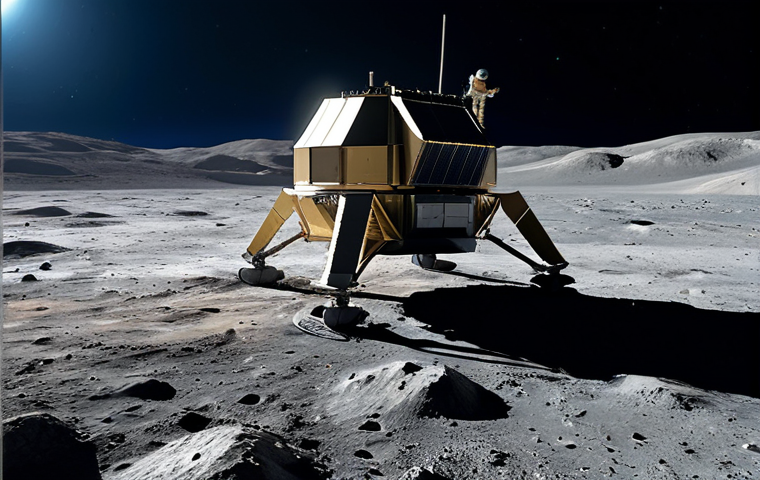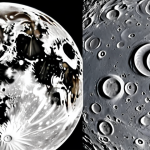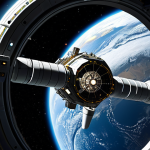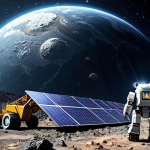Hey everyone! So, who else has been utterly glued to their screens, watching all the incredible, sometimes nail-biting, advancements happening in space lately?
It feels like we’re truly on the cusp of a new golden age of space exploration, and honestly, I’m here for every single moment of it. I’ve always been fascinated by the Moon, and right now, the technology behind lunar probe development is absolutely exploding with innovation.
It’s not just governments anymore; private companies are making massive strides, pushing boundaries we only dreamed of a decade ago, like Intuitive Machines successfully landing on the Moon, proving that commercial space travel is here to stay.
We’re talking about everything from advanced robotics and AI-powered rovers that can autonomously map and explore treacherous terrains to developing sustainable life support systems and even finding ways to ‘live off the land’ by utilizing lunar resources like water ice.
This isn’t just science fiction anymore; it’s our rapidly approaching reality, and the implications for humanity are monumental, paving the way for sustained human presence and even future missions to Mars.
The sheer ingenuity involved in overcoming challenges like extreme temperatures, communication delays, and the harsh lunar dust truly blows my mind. There’s a tangible excitement in the air, a feeling that we’re collectively embarking on humanity’s next giant leap.
So, if you’re as thrilled as I am about what the future holds for lunar exploration, I’m going to tell you exactly what’s going on and what’s coming next!
Hey everyone! So, who else has been utterly glued to their screens, watching all the incredible, sometimes nail-biting, advancements happening in space lately?
It feels like we’re truly on the cusp of a new golden age of space exploration, and honestly, I’m here for every single moment of it. I’ve always been fascinated by the Moon, and right now, the technology behind lunar probe development is absolutely exploding with innovation.
It’s not just governments anymore; private companies are making massive strides, pushing boundaries we only dreamed of a decade ago, like Intuitive Machines successfully landing on the Moon, proving that commercial space travel is here to stay.
We’re talking about everything from advanced robotics and AI-powered rovers that can autonomously map and explore treacherous terrains to developing sustainable life support systems and even finding ways to ‘live off the land’ by utilizing lunar resources like water ice.
This isn’t just science fiction anymore; it’s our rapidly approaching reality, and the implications for humanity are monumental, paving the way for sustained human presence and even future missions to Mars.
The sheer ingenuity involved in overcoming challenges like extreme temperatures, communication delays, and the harsh lunar dust truly blows my mind. There’s a tangible excitement in the air, a feeling that we’re collectively embarking on humanity’s next giant leap.
So, if you’re as thrilled as I am about what the future holds for lunar exploration, I’m going to tell you exactly what’s going on and what’s coming next!
Landing on the Moon: It’s a Wild Ride, and the Private Sector is Leading the Charge!

Okay, so remember when space exploration was pretty much just government agencies doing all the heavy lifting? Well, strap in, because that era is *gone*. I’ve been absolutely fascinated watching how private companies have rocketed into the lunar scene, shaking things up in the most incredible ways. Just look at Intuitive Machines – their Odysseus lander, the IM-1 mission, successfully touched down on the Moon in February 2024. Can you believe it? That was a massive win, proving that commercial entities aren’t just dabbling; they’re making history! It really hit home for me, seeing how this opens up the Moon to so many more possibilities, not just for national space agencies, but for bold entrepreneurs with big dreams. It’s truly a testament to innovation and the sheer will to push boundaries, even when the odds feel stacked against you, because let’s be honest, landing on the Moon is incredibly difficult. This kind of success changes everything we thought we knew about access to space, making lunar exploration more dynamic and accessible than ever before. We’re seeing a fundamental shift in who gets to go to the Moon and what they can achieve there, and honestly, it’s one of the most exciting developments I’ve witnessed in my lifetime. This new era is bringing forth a vibrant, competitive, yet collaborative landscape.
| Mission Name | Company/Agency | Key Goal/Status | Year |
|---|---|---|---|
| IM-1 (Odysseus) | Intuitive Machines | First commercial soft landing on Moon (Successful) | 2024 |
| SLIM (Moon Sniper) | JAXA (Japan) | Pinpoint landing demonstration (Successful) | 2024 |
| Chandrayaan-3 | ISRO (India) | South Pole landing, water ice search (Successful) | 2023 |
| Peregrine Mission 1 | Astrobotic Technology | Attempted commercial lunar landing (Failed) | 2024 |
| Chang’e 6 | CNSA (China) | First lunar far-side sample return (Successful) | 2024 |
| CADRE Mission (IM-3) | NASA/Intuitive Machines | Autonomous multi-rover collaboration (Planned) | Early 2026 |
The Rise of Commercial Lunar Payload Services (CLPS)
This whole shift didn’t just happen overnight; it’s largely thanks to initiatives like NASA’s Commercial Lunar Payload Services (CLPS) program. NASA basically says, “Hey private industry, can you deliver our science instruments to the Moon for us?” and companies like Intuitive Machines, Astrobotic, and Firefly Aerospace step up to the plate. It’s a genius move because it lowers costs for NASA, speeds up development, and fosters a whole new lunar economy. I mean, who wouldn’t want to see more players in this game? We’ve seen some incredible attempts and even some heart-wrenching failures, like Astrobotic’s Peregrine mission or ispace’s earlier tries, which remind us just how challenging this endeavor truly is. But even those moments of adversity provide invaluable lessons, pushing everyone to innovate even faster. The CLPS model is really showing us how much can be achieved when innovation meets opportunity, and it’s exhilarating to watch these companies carve out their place in the cosmos. It’s a competitive market, sure, but it’s pushing everyone to be better and bolder, which is exactly what we need for true progress.
International Players Stepping Up Their Game
And it’s not just the US private sector making waves! Other nations are seriously upping their lunar game, showcasing some mind-blowing precision and ingenuity. Take Japan’s SLIM (Smart Lander for Investigating Moon) mission – they successfully landed on the Moon in January 2024 and achieved a pinpoint landing within 100 meters of their target site. How cool is that for accuracy? That kind of precision is crucial for future missions targeting specific, resource-rich areas. India also made history with its Chandrayaan-3 mission, successfully landing near the lunar South Pole in August 2023, a region of immense scientific interest due as it’s believed to hold significant water ice reserves. Even China’s Chang’e 6 mission, launched in May 2024, performed the first sample return from the lunar far side. This global participation isn’t just a “race” anymore; it’s a collective push towards understanding our celestial neighbor better, and it brings a fantastic diversity of approaches and technologies to the table. It’s inspiring to see so many brilliant minds from around the world contributing to this shared human endeavor, pushing the boundaries of what’s possible in space exploration, and I honestly think this global collaboration is key to our long-term success out there.
Robots Taking Over? Autonomous Explorers are Changing the Game
If you’re anything like me, you probably grew up with sci-fi movies showing super-smart robots zipping around alien landscapes. Well, guess what? That future is pretty much *now* on the Moon! The advancements in AI and robotics for lunar exploration are seriously blowing my mind. We’re talking about rovers that aren’t just remote-controlled toys; they’re becoming increasingly autonomous, capable of making real-time decisions about navigation, obstacle avoidance, and even scientific data collection without direct human commands from Earth. Imagine the sheer capability this unleashes! These intelligent machines are designed to operate in environments far too harsh or risky for humans, giving us eyes and hands in places we could only dream of reaching before. It’s like having an army of super-smart geologists and engineers exploring for us, tirelessly working through the lunar day and, increasingly, even surviving the brutal lunar night, which is a game-changer for continuous exploration. The idea of a fleet of robots collaborating on tasks, sharing data, and collectively mapping vast, uncharted territories is no longer just theoretical; it’s becoming our reality, and it’s incredibly exciting to think about what they’ll uncover for us.
Smart Rovers and AI-Powered Navigation
One of the coolest developments I’ve been tracking is how AI is transforming rover capabilities. Projects like NASA’s CADRE (Cooperative Autonomous Distributed Robotic Exploration) mission are all about proving that multiple robots can work together autonomously to gather data. We’re talking about suitcase-sized rovers, set to launch aboard Intuitive Machines’ IM-3 mission, that will coordinate via radio, map terrain in 3D using cameras and ground-penetrating radar, and essentially plan their own exploration strategy. It’s not just about one rover anymore; it’s about a *team* working in sync! Then there’s the SAMLER-KI project, a collaboration between German researchers, focusing on a semi-autonomous micro-rover designed to *survive lunar nights*. Think about the challenges: extreme temperatures, radiation, dust – these robots are being built to withstand it all, and AI is at the heart of their resilience and ability to keep going. It’s about more than just moving around; it’s about intelligent decision-making on a surface where every gram of energy and every degree of temperature fluctuation matters. This leap in autonomous navigation and risk assessment is critical for pushing the boundaries of where and how we explore.
Beyond Wheels: New Forms of Lunar Mobility
And it’s not just rovers with wheels that are getting smarter! We’re seeing concepts for entirely new forms of lunar mobility, especially for exploring those tricky, permanently shadowed regions (PSRs) within craters where water ice is believed to be hidden. Imagine little hopping robots, like the Micro Nova Hopper that Intuitive Machines is looking to deploy as part of their IM-2 mission. These little guys could potentially hop into and out of those deep, dark craters, giving us access to areas previously impossible to reach. This kind of innovative thinking about how to move across and explore the incredibly diverse lunar landscape is what’s going to unlock some of the Moon’s deepest secrets. It’s a testament to the ingenuity of engineers and scientists who aren’t just sticking to the tried-and-true, but are constantly brainstorming new ways to tackle the unique challenges presented by our cosmic neighbor. The future of lunar mobility is looking incredibly diverse and, frankly, super cool!
Living Off the Land: Making the Moon Our Sustainable Home
This is where things get really exciting for the long-term vision of lunar exploration: the concept of In-Situ Resource Utilization (ISRU), or simply put, living off the land! For years, we’ve had to haul everything from Earth – water, oxygen, even construction materials. But with ISRU, the goal is to harness the Moon’s own resources to support missions and reduce our reliance on Earth-based supplies. I mean, shipping stuff into space is ridiculously expensive, right? So, if we can make rocket fuel or breathable air right there on the Moon, that’s a game-changer for making a sustained human presence actually *sustainable*. We’re talking about taking lunar dirt (regolith) and water ice and turning them into everything we need. It’s not just a nice-to-have; it’s absolutely essential for any kind of permanent lunar base or even for refueling spacecraft heading to Mars. The potential impact on mission costs and complexity is truly monumental, paving the way for a future where humanity isn’t just visiting the Moon, but truly making it a second home.
Unlocking Lunar Water Ice
The biggest prize in the ISRU game right now is lunar water ice. Satellites have confirmed its presence, especially in the permanently shadowed regions at the Moon’s poles, and missions like India’s Chandrayaan-3 successfully landed near the South Pole to investigate further. Imagine being able to extract that water! We could use it directly for drinking, for growing food, or – and this is the really exciting part – split it into hydrogen and oxygen through electrolysis. Hydrogen and oxygen are not only essential for life support but also happen to be potent rocket propellants. Lockheed Martin, for instance, has a vision for a “water-based lunar architecture,” seeing water as the ultimate game-changer for cislunar and interplanetary missions, because it can be used for breathing, drinking, and fuel. So, every mission that helps us map, understand, and eventually extract this precious resource is a huge step forward. While missions like NASA’s VIPER rover (Volatiles Investigating Polar Exploration Rover) faced cancellations, the insights gained continue to drive advancements, with CubeSat missions like Lunar Flashlight still on the hunt to better locate and quantify water ice deposits. It’s a complex challenge, but the payoff is immense.
From Lunar Dust to Building Blocks
Beyond water, the Moon’s regolith – that dusty, rocky material covering its surface – is another incredible resource. Scientists and engineers are actively developing ways to use it for construction and manufacturing right on site! Think about it: instead of hauling heavy building materials from Earth, we could 3D print structures, landing pads, and even entire habitats using lunar dust. Companies like Redwire Space, for example, are demonstrating regolith-based in-space manufacturing with their Redwire Regolith Print (RRP) mission, testing 3D printing with simulated lunar regolith on the International Space Station. While 3D printing with simulated regolith has been done on Earth, doing it in the actual space environment is the next big validation step. This isn’t just about making things easier; it’s about enabling a self-sufficient lunar outpost, a true “Artemis Base Camp,” where astronauts can have tools, furniture, and shielded structures produced on demand. The ability to effectively “mine” and “build” with lunar materials will drastically reduce our logistical burden and open up possibilities for a truly expansive and sustainable human presence far beyond what we can achieve today.
Powering Through Lunar Nights: Energy for a Permanent Presence
One of the biggest hurdles for anything long-term on the Moon is power, especially surviving those incredibly long, brutal lunar nights that can last for 14 Earth days and plunge temperatures to extreme lows. If we’re going to have a sustained human presence, or even keep our robotic explorers working around the clock, reliable and continuous energy is absolutely non-negotiable. Solar panels are great during the lunar day, of course, but what happens when the sun goes down? That’s where some seriously innovative thinking comes into play. We need robust systems that can either store immense amounts of energy or generate it independently of sunlight. This isn’t just about keeping the lights on; it’s about powering life support systems, resource extraction equipment, communications, and all the scientific instruments that make lunar exploration so valuable. It’s a challenge that many brilliant minds are tackling, recognizing that energy independence is foundational to making the Moon our permanent outpost.
Next-Gen Solar and Battery Solutions
For operations during the lunar day, solar power remains a primary workhorse, but it’s evolving. We’re looking at more efficient, lightweight, and deployable solar arrays that can maximize energy capture. The real trick, however, is dealing with the night. This involves advanced battery technologies that can store enough energy from the daylight hours to last through the frigid darkness. Imagine batteries that are not only incredibly powerful but also resilient to the extreme temperature swings and radiation. Engineers are pushing the boundaries of material science and energy storage to create solutions that are compact, durable, and reliable. Moreover, innovative ideas like strategically placed solar farms that can continuously receive sunlight, even during low-sun periods, are being explored. The goal is to develop a power infrastructure that can support continuous operations, allowing rovers and habitats to function without interruption, transforming how we approach sustained lunar presence and ensuring that our lunar ambitions aren’t limited by the rotation of the Moon.
The Promise of Nuclear Fission Power
Beyond solar and batteries, nuclear fission power is emerging as a true game-changer for continuous lunar operations. Think about it: a small, lightweight fission power system could provide consistent energy, day or night, irrespective of sunlight. Lockheed Martin is a big believer in this, seeing nuclear fission power as critical for both generating electricity on the lunar surface and even for propelling spacecraft with nuclear thermal propulsion (NTP), offering higher thrust and efficiency. This technology would be a huge leap forward, providing the kind of robust and continuous power needed for large-scale operations, like extracting and processing lunar resources, establishing substantial habitats, and even powering future missions to Mars. Developing these systems is complex, involving significant engineering challenges, but the benefits – from powering scientific instruments in permanently shadowed regions to providing abundant energy for a bustling lunar base – are too immense to ignore. It truly represents the next frontier in providing sustained power for off-world endeavors, freeing us from the constraints of solar cycles.
Building Our Future: From Regolith to Habitats
When I picture a future on the Moon, it’s not just a temporary camp; it’s a place where humans can live and work for extended periods, perhaps even permanently. And to do that, we need homes, not just tents! That’s why the technology for building sustainable infrastructure directly on the lunar surface is so incredibly vital and fascinating. We’re talking about transforming the Moon’s own “dirt”—regolith—into building materials. This isn’t just about making things look pretty; it’s about creating radiation-shielded habitats, sturdy landing pads, and even roads, all without having to launch every single brick and beam from Earth. The challenges are enormous, from dealing with fine, abrasive lunar dust to working in vacuum and extreme temperatures, but the ingenuity being poured into these solutions is truly inspiring. I mean, who would have thought that lunar soil could become our future construction material? It’s a huge step towards true self-sufficiency off-world, reducing the cost and complexity of establishing a sustained human presence, and it’s a testament to human innovation.
3D Printing with Lunar Regolith
One of the most promising avenues for lunar construction is 3D printing. Imagine sending robotic printers to the Moon ahead of astronauts, where they can autonomously build structures using local materials. Companies like Redwire Space are at the forefront of this, demonstrating how regolith can be used as a feedstock for in-space manufacturing. This means we could print everything from basic infrastructure like landing pads and protective berms to complex components for habitats and tools. It significantly reduces the mass we need to launch from Earth, making missions more affordable and sustainable. The ability to create custom parts and structures on demand, tailored to the specific needs of a lunar base, is a game-changer. It’s about more than just building; it’s about creating an entire supply chain and manufacturing capability that is independent of Earth. This innovation will be crucial for establishing Artemis Base Camp and other future outposts, providing the necessary infrastructure to support human life and scientific exploration for years to come. I really believe this is how we’ll genuinely settle amongst the stars!
Shielding from the Harsh Environment
Beyond simply building structures, we need to make sure they’re safe. The Moon’s surface is a pretty unforgiving place, constantly bombarded by radiation from the sun and cosmic rays, not to mention the extreme temperature fluctuations. So, a massive focus is on developing materials and construction techniques that provide adequate shielding. Lunar regolith itself, when properly processed and utilized, can act as a natural radiation shield, which is a huge advantage. Researchers are looking into layered construction, inflatable habitats that can be covered with regolith, and other innovative designs that maximize protection while minimizing the need for Earth-sourced materials. This focus on “extreme environment access” and “lunar dust mitigation” is part of NASA’s Lunar Surface Innovation Initiative, highlighting how foundational these capabilities are for protecting astronauts and equipment. It’s not just about building a house; it’s about building a fortress against the cosmos, ensuring that our brave explorers have a safe and secure place to call home on the Moon. This kind of protective engineering is absolutely essential for humanity’s long-term survival off-world.
The Artemis Generation: Humanity’s Next Giant Leaps (and Stumbles!)
The Artemis program, spearheaded by NASA, truly embodies humanity’s audacious ambition to return to the Moon, not just for a fleeting visit, but to establish a sustainable presence. It feels like the direct descendant of Apollo, but with a much grander vision: a long-term base at the lunar South Pole and a stepping stone for future human missions to Mars. This isn’t just a government initiative; it’s a global collaboration, bringing in international partners and commercial companies, creating a robust lunar marketplace. We’re talking about the Space Launch System (SLS) rocket, the Orion spacecraft, human landing systems (HLS) like SpaceX’s Starship variant, and the Lunar Gateway space station orbiting the Moon. It’s an incredibly complex undertaking, and I’ve been following every announcement and update, feeling the sheer weight and excitement of what it means for our species. This isn’t just about putting boots on the Moon; it’s about learning how to live and work on another world, pushing our technological and psychological limits, and preparing for that ultimate goal of Mars. It’s a journey filled with incredible breakthroughs, but also, as we’ve seen, inevitable challenges and adjustments, which are all part of pushing the boundaries of what’s possible.
Artemis Missions: A Stepping Stone to Mars
The Artemis program is meticulously planned with a series of missions, each building upon the last. Artemis I, an uncrewed flight test, was a huge success, proving out the SLS and Orion. Artemis II, the first crewed mission around the Moon, is now targeted for April 2026, and you better believe I’m going to be glued to my screen for that! Then comes Artemis III, which is planned to land astronauts near the lunar South Pole. While initially hoped for 2025, it’s now expected no earlier than mid-2027, due to some of those inevitable development challenges with the human landing system and new spacesuits. It reminds us that space exploration is hard, and safety always comes first. But these delays are just speed bumps on the road to a monumental achievement. Subsequent missions like Artemis IV and V will involve docking with the Lunar Gateway, humanity’s first lunar space station, and delivering new elements and equipment. Each mission is a critical testbed, not only for lunar operations but also for proving out the technologies and procedures that will be essential for sending humans to Mars in the 2030s. It’s a methodical, step-by-step approach, ensuring we learn everything we can before taking that next giant leap.
Developing the Lunar Ecosystem
Beyond the individual missions, Artemis is fostering a much broader lunar ecosystem. This includes developing entirely new infrastructure elements: lunar terrain vehicles (LTVs) for extended surface exploration, next-generation spacesuits that offer greater mobility and protection, and advanced communication systems like the GPS-like network being established around the Moon. NASA’s CLPS initiative plays a crucial role here, with commercial companies delivering science and technology payloads that help de-risk future crewed missions and test out new capabilities. The vision is to build a “Lunar Base Camp” at the South Pole, a self-sustaining outpost where humans can live and conduct long-duration scientific activities. This requires integrating all these diverse technologies – from ISRU for resources to nuclear power for energy and 3D printing for construction. It’s a complex dance of government, international, and commercial partners, all working towards a common goal of a permanent human presence. The sheer scale of this undertaking, and the incredible human capital being invested, really makes me feel optimistic about our species’ future in space.
Beyond Borders: A Global Race, But Also a Collaboration
It’s easy to look at all the different countries and companies vying for a piece of the Moon and think it’s just a new “space race,” echoing the Cold War era. And in some ways, it is a competition, pushing everyone to innovate faster and aim higher. But what I find even more compelling is the incredible spirit of collaboration that’s also at play. We’re seeing nations partner up, sharing expertise and resources, recognizing that the challenges of lunar exploration are so immense that no single entity can or should tackle them alone. It’s a nuanced dance between competition and cooperation, and honestly, I think that balance is what’s driving such rapid progress. This international synergy is creating a more resilient and diverse approach to exploring our nearest celestial neighbor, which ultimately benefits all of humanity. It truly is a testament to the idea that when we set our sights on something as grand as the Moon, the best way forward is often together, leveraging the strengths of many rather than just one.
Strategic Partnerships for Shared Goals
Examples of this collaboration are everywhere if you look closely. The Artemis program itself is a prime example, involving international partners like the European Space Agency (ESA), Japan Aerospace Exploration Agency (JAXA), and other nations under the Artemis Accords, which set out principles for peaceful and sustainable space exploration. These partnerships are not just symbolic; they involve tangible contributions, like the European Service Module for the Orion spacecraft. On the scientific front, India and Japan are collaborating on the Lunar Polar Exploration Mission (LUPEX), which aims to deploy a rover to the Moon’s South Pole to directly assess water ice, building on India’s Chandrayaan-3 success. Even commercial ventures, like ispace partnering with the UAE for the Rashid rover, highlight this interconnectedness. These alliances mean shared risks, shared costs, and shared rewards, making ambitious missions more feasible and robust. It’s a recognition that the ultimate goal – understanding and utilizing the Moon for humanity’s benefit – is a shared one, even if the paths to get there are varied and competitive. I really believe these partnerships are crucial for building a sustainable, long-term presence beyond Earth.
The Moon as a Proving Ground for Humanity
Ultimately, all this incredible activity on and around the Moon serves a greater purpose: to establish the Moon as a proving ground, a vital testbed for humanity’s future in deep space, particularly for Mars missions. Everything we learn about living off-world, from extracting resources and building habitats to operating autonomous robots and developing long-duration life support systems, directly prepares us for the even greater challenges of the Red Planet. The Moon offers a relatively close and accessible environment to test technologies and procedures in a real space context, without the much longer communication delays and harsher conditions of Mars. NASA’s “Moon to Mars” program is explicit about this connection. By mastering sustainable operations on the Moon, we’re not just expanding our reach; we’re building the foundational knowledge and infrastructure for becoming a multi-planetary species. It’s a breathtaking vision, and every piece of technology, every successful landing, every scientific discovery, is a step towards making that extraordinary future a reality. It’s a truly exciting time to be alive, witnessing humanity collectively taking these monumental steps!
Closing Thoughts
Wow, what an incredible journey we’ve taken through the lunar landscape and the cutting-edge tech that’s shaping its future! I truly hope you’ve felt that palpable sense of excitement I feel every single day watching these developments unfold.
It’s not just about science fiction anymore; it’s about our shared human destiny, and the Moon is clearly our next big frontier. From the ingenious private missions to the groundbreaking robots and the revolutionary idea of living off the land, we’re not just visitors anymore; we’re becoming residents.
So, let’s keep our eyes to the skies, because the best, most thrilling chapters of lunar exploration are still unwritten, and I, for one, can’t wait to see what amazing discoveries await us!
Useful Information to Know
1. It’s truly mind-boggling to see how private companies, thanks to initiatives like NASA’s CLPS program, are now at the forefront of lunar exploration. This isn’t just about big government agencies anymore; it’s a dynamic, competitive marketplace that’s driving innovation at an unprecedented pace, making lunar access more affordable and frequent. Keep an eye on names like Intuitive Machines and Astrobotic; they’re the pioneers of this new era, taking calculated risks and pushing the boundaries of what’s commercially viable in deep space. Their successes, and even their valuable learning experiences from failures, are paving the way for a more diverse and accessible lunar future for everyone involved in this incredible endeavor.
2. The sheer intelligence being built into lunar rovers and landers is breathtaking. We’re moving beyond simple remote control to sophisticated AI-powered systems that can navigate complex terrains, avoid hazards, and even conduct scientific experiments autonomously. This means explorers can gather more data in more challenging environments, like those deep, permanently shadowed craters, without constant human intervention. Missions like CADRE and innovative concepts for hopping robots are showcasing how these intelligent machines are essentially becoming our tireless, resilient eyes and hands on the Moon, vastly expanding our exploratory capabilities and transforming how we interact with alien landscapes.
3. Seriously, the idea of using the Moon’s own resources – like water ice and regolith – to build habitats and make rocket fuel is a total game-changer for sustained human presence. It’s not just a cool concept; it’s a fundamental shift in how we approach space travel, drastically cutting down on the monumental costs of launching everything from Earth. Imagine a future where lunar bases are largely self-sufficient, producing their own water, oxygen, and even construction materials. This capability is absolutely essential for transforming temporary visits into permanent outposts, paving the way for truly self-sustaining colonies and making our journey to Mars much more feasible.
4. NASA’s Artemis program is more than just a return to the Moon; it’s a meticulously planned, international effort to establish a permanent human presence at the lunar South Pole, with a clear eye on Mars as the ultimate destination. This isn’t a race of the past; it’s a collaborative global endeavor bringing together nations and private industry under the Artemis Accords, fostering sustainable and peaceful exploration. While there are always challenges and schedule adjustments in such monumental undertakings, each mission, from Artemis I’s uncrewed success to the upcoming crewed flights, is a critical step in building the knowledge, technology, and infrastructure needed for humanity’s multi-planetary future.
5. While competition undoubtedly fuels innovation, I’ve been so heartened to see the incredible international collaborations blossoming in lunar exploration. Projects like the India-Japan LUPEX mission or the European Service Module for Orion show that nations are increasingly recognizing the immense benefits of sharing expertise and resources. The Moon is a shared heritage, and tackling its immense challenges together, with diverse perspectives and technological approaches, makes the entire endeavor more robust, efficient, and ultimately, more successful for all of humanity. It truly is a testament to what we can achieve when we work across borders for a common, inspiring goal.
Key Takeaways
As we wrap up our deep dive into the incredible world of lunar exploration, I want to leave you with a few core ideas that I feel are absolutely crucial for understanding where we’re headed.
First off, the commercial sector isn’t just a supporting act anymore; it’s a central, driving force, bringing unprecedented agility and innovation to the lunar surface.
We’re seeing a fundamental democratization of space access that will only accelerate. Secondly, the integration of advanced AI and robotics is not just making exploration safer, but far more efficient and capable, allowing us to venture into previously inaccessible terrains and conduct complex science autonomously.
And perhaps most importantly, the focus on In-Situ Resource Utilization (ISRU) and sustainable infrastructure is changing the game entirely – we’re shifting from simply visiting to truly *living* and *working* on the Moon, transforming it into a vital proving ground and a stepping stone for our journey to Mars.
This isn’t just about putting flags on a new rock; it’s about expanding humanity’s presence beyond Earth in a sustainable, collaborative, and incredibly exciting way.
The future of the Moon is bright, and honestly, the best is yet to come!
Frequently Asked Questions (FAQ) 📖
Q: What are the most exciting technologies currently propelling us into this new era of lunar exploration?
A: Honestly, it’s a convergence of so many incredible breakthroughs that it almost feels like science fiction becoming reality! From my perspective, having keenly followed these developments, the real game-changers are the advancements in AI-powered robotics and autonomous systems.
We’re not just talking about simple rovers anymore; these machines can map complex terrains, identify potential resources like water ice, and even make crucial decisions without constant human oversight, which is absolutely vital given the communication delays between Earth and the Moon.
Think about it: a robot that can assess a situation and adapt, exploring shadowy craters or navigating treacherous rocky expanses all on its own. That’s a massive leap!
It’s truly mind-blowing to consider the precision and independence these new generations of robotic explorers bring to the table. Then there’s the monumental progress in sustainable life support systems.
This isn’t just about packing enough oxygen and food for a short trip; it’s about creating closed-loop systems that can recycle air and water, allowing for extended stays.
Coupled with that, the focus on In-Situ Resource Utilization (ISRU) is truly revolutionary. My mind is constantly blown by the idea of “living off the land” on the Moon!
Imagine extracting water from lunar ice, which can then be used for drinking, growing food, and even split into hydrogen and oxygen for rocket fuel. This significantly reduces the amount of supplies we need to launch from Earth, making long-duration missions and even a permanent lunar presence far more feasible and affordable.
We’re talking about building actual habitats, not just temporary shelters, and these technologies are the bedrock for making that happen. It’s truly inspiring to see how engineering ingenuity is tackling such formidable challenges head-on, paving the way for humanity’s sustained presence beyond Earth and setting us up for future missions to Mars.
Q: How significant is the role of private companies, like Intuitive Machines, in driving this new era of lunar exploration, and what are they bringing to the table?
A: Oh my goodness, the impact of private companies in space exploration is absolutely colossal, and I can tell you firsthand, it’s one of the most exciting shifts I’ve witnessed in my lifetime!
For decades, space was primarily the domain of government agencies, but now, companies like Intuitive Machines are not just participants; they’re genuine trailblazers, accelerating progress at an unprecedented rate.
What they bring to the table is a fantastic blend of innovation, agility, and cost-effectiveness. It’s fundamentally changing the game. Unlike traditional government programs, which can sometimes be bound by complex bureaucratic processes and lengthy development cycles, private companies often operate with a lean, entrepreneurial spirit.
This allows them to iterate faster, take calculated risks, and develop new technologies with incredible speed. Intuitive Machines’ successful landing on the Moon with their Nova-C lander, Odysseus, was a monumental moment.
It wasn’t just a technical achievement; it was a powerful demonstration that commercial entities can execute highly complex, deep-space missions, proving that commercial space travel is truly here to stay.
This commercial approach is democratizing access to space. It means more missions, more scientific data, and more opportunities for diverse ideas to flourish.
They’re pioneering new business models, fostering healthy competition, and ultimately driving down the cost of access to space. From building better, more efficient landers and rovers to developing new propulsion systems and even thinking about lunar logistics and infrastructure, these companies are essential partners in opening up the Moon to a wider range of explorers and innovators.
They’re proving that the future of space isn’t just about national pride; it’s about collaborative human endeavor, pushing the boundaries of what’s possible, and making space more accessible for everyone.
Q: What are the biggest challenges we’re still grappling with on the Moon, and what are the ultimate goals we hope to achieve by overcoming them?
A: You know, as much as we celebrate the incredible progress, the Moon is still a seriously tough environment, and we’re definitely still grappling with some monumental challenges.
From my experience watching these missions unfold, a few really stand out. First, there’s the extreme temperature swings. Lunar days and nights last about two Earth weeks each, meaning temperatures can plummet to a brutal -250°F (-157°C) and soar to a scorching 250°F (121°C).
Designing hardware that can survive and operate reliably through those kinds of thermal extremes is no small feat. It requires incredibly robust materials and ingenious thermal management systems to keep sensitive electronics and human habitats functioning.
It’s a constant battle against the elements! Then there’s the infamous lunar dust. Oh boy, this stuff is not your average terrestrial dirt!
It’s incredibly abrasive, clingy, and electrostatically charged, meaning it gets everywhere, sticks to everything, and can wreak havoc on equipment, clog seals, and even scratch optics.
Astronauts from the Apollo missions described it as feeling and smelling like gunpowder, and it caused significant issues for their gear. It’s a genuine pain point for every mission, and scientists and engineers are constantly working on new ways to mitigate its effects, from specialized coatings to dust-repelling technologies.
Finally, communication delays are a constant hurdle. Even though the Moon is relatively close, the lag in sending and receiving signals means real-time, joystick-style control isn’t feasible, which is why autonomous systems and robust mission planning are so crucial.
Now, why go through all this trouble? The ultimate goals are truly awe-inspiring and deeply rooted in humanity’s future. Overcoming these challenges isn’t just for bragging rights; it’s about paving the way for sustained human presence on the Moon.
Imagine permanent research stations, potentially even lunar settlements, serving as a crucial stepping stone for deeper space exploration. The Moon is a fantastic testing ground for technologies and strategies we’ll need for missions to Mars and beyond.
By learning to live and work sustainably on the Moon – utilizing its resources, developing advanced robotics, and building robust habitats – we’re essentially writing the blueprint for how humanity will become a multi-planetary species.
It’s about expanding our knowledge, securing potential resources for future generations, and frankly, fulfilling that deep-seated human drive to explore the unknown.
Every challenge overcome brings us closer to that truly monumental next giant leap for all humankind.
📚 References
Wikipedia Encyclopedia
구글 검색 결과
구글 검색 결과
구글 검색 결과
구글 검색 결과
구글 검색 결과






